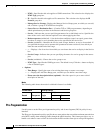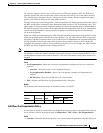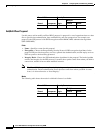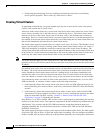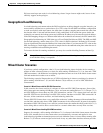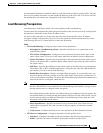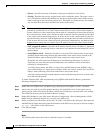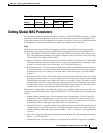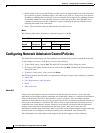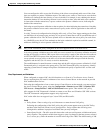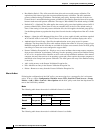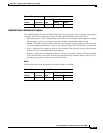
68-26
Cisco ASA 5500 Series Configuration Guide using ASDM
Chapter 68 Configuring IKE, Load Balancing, and NAC
Configuring Load Balancing
Therefore, it cannot assign a combination of IPsec and SSL VPN session loads properly to ASA devices
running earlier versions nor to VPN 3000 Concentrators. Conversely, a VPN 3000 Concentrator acting
as the cluster master cannot assign loads properly to an ASA Release 7.1(1) ASA. The following
scenario illustrates this dilemma.
This scenario is similar to the previous one, in that the cluster consists of a mixture of ASAs and VPN
3000 Concentrators. Some of the ASA cluster peers are running ASA Release 7.0,(x) and some are
running Release 7.1(1). In this case, however, the cluster is handling SSL VPN connections as well as
IPsec connections.
If a device that is running software earlier than ASA Release 7.1(1) is the cluster master, the master
applies the protocol and logic in effect prior to Release 7.1(1). That is, sessions might be directed to
load-balancing peers that have exceeded their session limit. In that case, the user is denied access.
If the cluster master is a device running ASA Release 7.0(x) software, the old session-weighting
algorithm applies only to the pre-7.1(1) peers in the cluster. No one should be denied access in this case.
Because the pre-7.1(1) peers use the session-weighting algorithm, they are more lightly loaded.
An issue arises, however, because you cannot guarantee that the 7.1(1) peer is always the cluster master.
If the cluster master fails, another peer assumes the role of master. The new master might be any of the
eligible peers. Because of the innately unpredictability of the results, we recommend that you avoid
configuring this type of cluster.
Comparing Load Balancing to Failover
Both load balancing and failover are high-availability features, but they function differently and have
different requirements. In some circumstances you can use both load balancing and failover. The
following sections describe the differences between these features.
Load balancing is a mechanism for equitably distributing remote-access VPN traffic among the devices
in a virtual cluster. It is based on simple distribution of traffic without taking into account throughput or
other factors. A load-balancing cluster consists of two or more devices, one of which is the virtual
master, and the others backup. These devices do not need to be of the exact same type, or have identical
software versions or configurations. All active devices in a virtual cluster carry session loads. Load
balancing directs traffic to the least loaded device in the cluster, distributing the load among all devices.
It makes efficient use of system resources and provides increased performance and high availability.
A failover configuration requires two identical ASAs connected to each other through a dedicated
failover link and, optionally, a stateful failover link. The health of the active interfaces and units is
monitored to determine when specific failover conditions are met. If those conditions occur, failover
occurs. Failover supports both VPN and firewall configurations.
The ASA supports two failover configurations, Active/Active failover and Active/Standby failover. VPN
connections run only in Active/Standby, single routed mode. Active/Active failover requires
multi-context mode, so does not support VPN connections.
With Active/Active failover, both units can pass network traffic. This is not true load balancing, although
it might appear to have the same effect. When failover occurs, the remaining active unit takes over
passing the combined traffic, based on he configured parameters. Therefore, when configuring
Active/Active failover, you must make sure that the combined traffic for both units is within the capacity
of each unit.
With Active/Standby failover, only one unit passes traffic, while the other unit waits in a standby state
and does not pass traffic. Active/Standby failover lets you use a second ASAto take over the functions
of a failed unit. When the active unit fails, it changes to the standby state, while the standby unit changes
to the active state. The unit that becomes active assumes the IP addresses (or, for transparent firewall,



